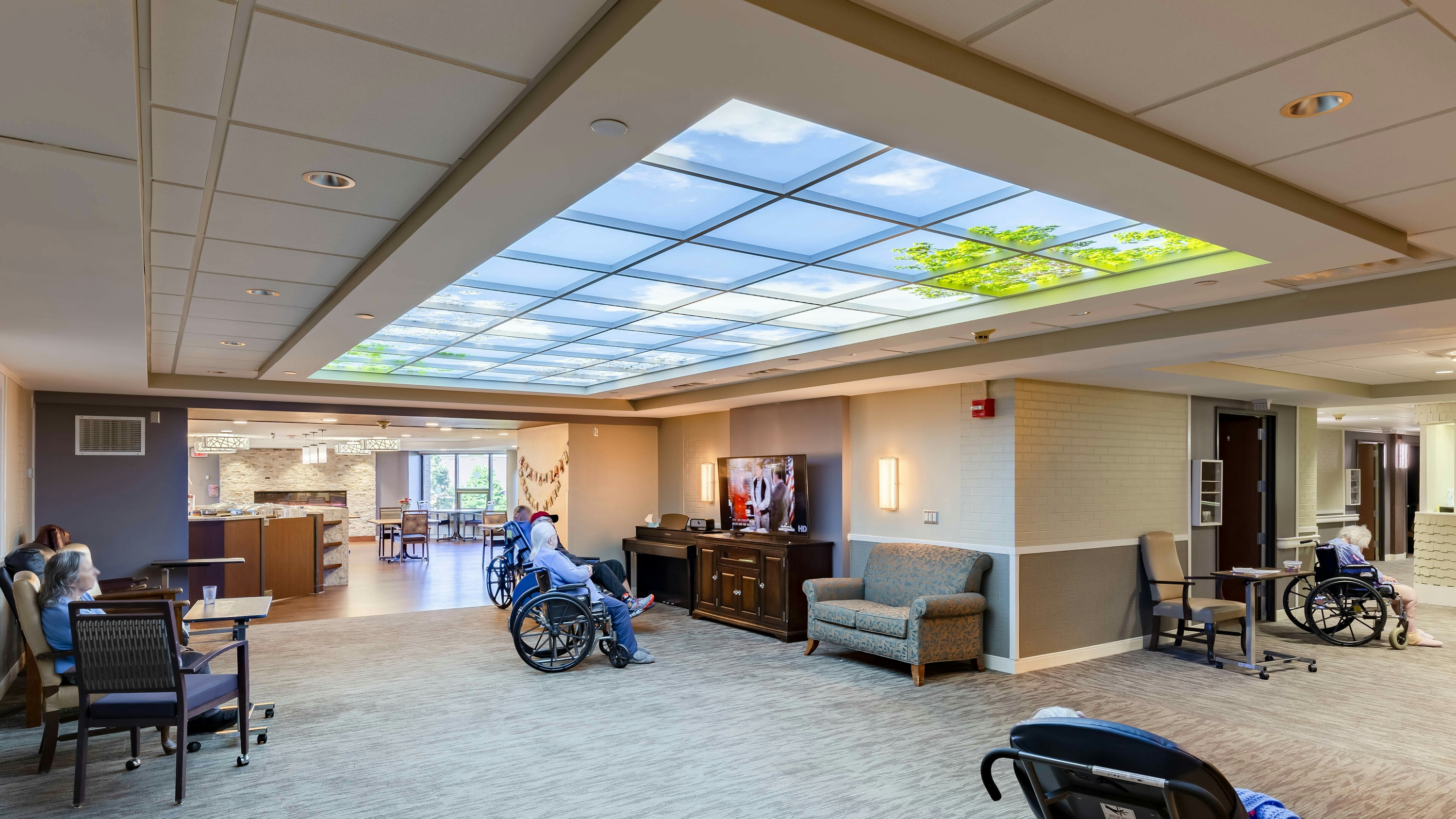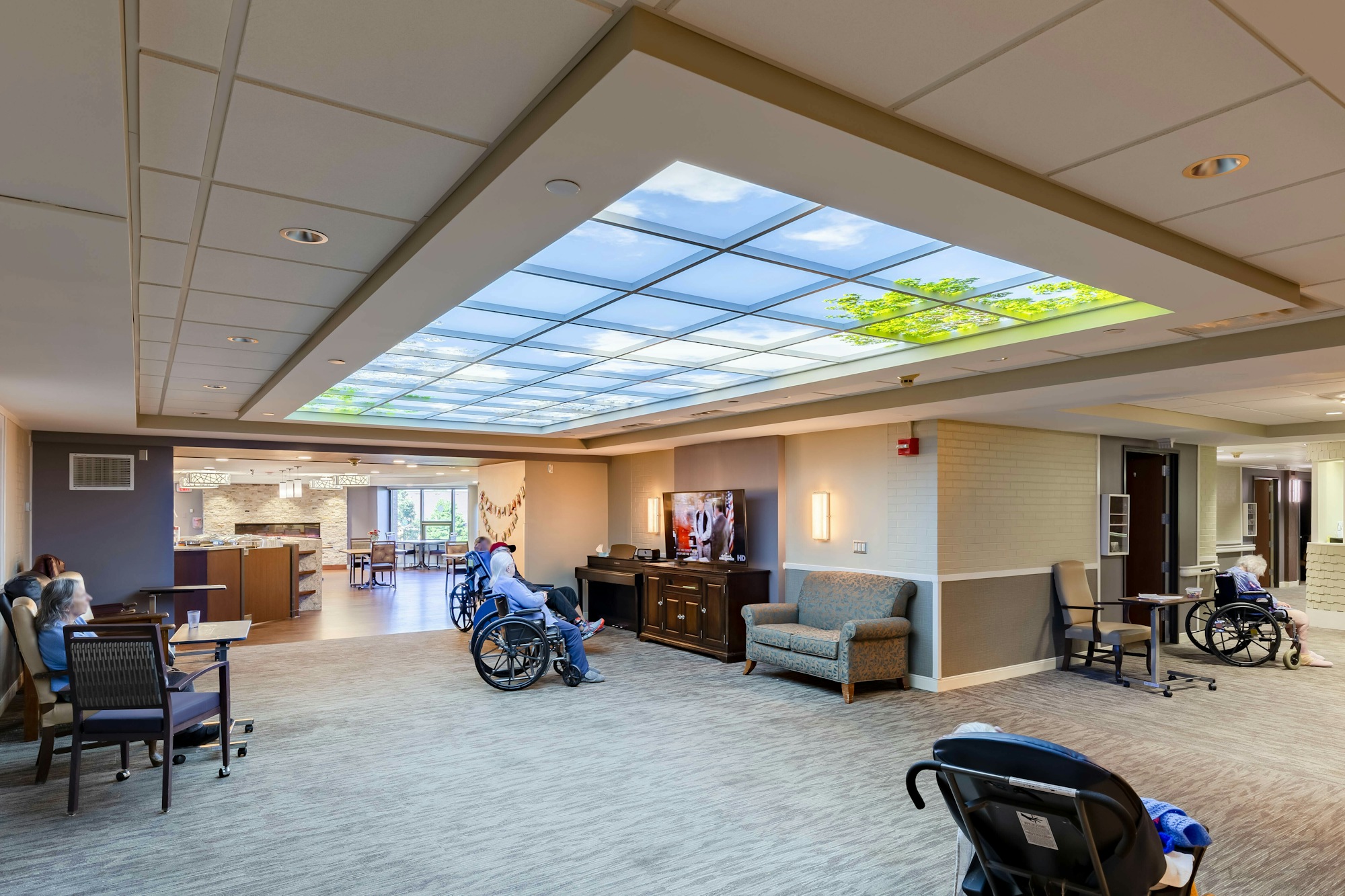
Learning Objectives
Lighting controls insights
As humans age, our eyes change shape and undergo a natural process that significantly impacts our vision and overall quality of life. By the time people are 40, they usually require twice as much light; by 60, they need three times as much. It becomes harder to focus on close objects, colors are difficult to distinguish and seeing in low-light conditions becomes more challenging. Unsurprisingly, most vision issues increase with age and data suggests that those 80 or older carry the heaviest burden of age-related eye disease.
Because of how aging affects overall eyesight, it’s essential to implement proper lighting in spaces designed for older adults. In these spaces, good lighting can also create more independence. Spaces with bright, natural light help reduce falls, increase socialization and stimulate positive physical and mental health. The elimination of glare is also essential, as it can lead to agitation and headaches. Designers and engineers must keep these age-related vision issues in mind when designing care communities, ensuring residents receive proper 24-hour care in a well-lit, safe environment that still maintains a homelike feel.
One key element in achieving this balance is through lighting controls, which play a crucial role in promoting well-being, enhancing mood and providing a sense of autonomy for residents of homes for older adults. The controls must not only meet energy code requirements but also ensure staff can perform their duties so residents feel comfortable, safe and cared for.
There are several best practices for incorporating lighting controls within different areas of care communities to positively impact residents’ well-being, including resident rooms, hallways, common rooms and outdoor spaces.
Focused lighting controls for resident rooms
There’s no better place to incorporate resident-focused lighting controls than within the respective resident rooms. Just like at home, residents spend much of their time in the comfort of their personal spaces. To ensure ultimate comfort and visibility, personalized lighting should be tailored to residents’ individual needs and preferences.
A great example of this is at the Minnesota Veterans Home in Preston, where controls for general overhead lighting and step lights are located at each entry door. Step lights deliver floor-level illumination, which properly lights walkways. Overhead lighting is dimmable, which allows staff and residents to adjust lighting for nighttime, cleaning and housekeeping activities. At the headwall, controls for residents include dimming controls for general lighting from downlights, accent uplighting and a night light in the bathroom. Residents can access any of these controls from the comfort of their bed, which helps to minimize fall risks.
In states requiring overbed exam lights, controls should be clearly labeled and located on the headwall to prevent guests and staff from inadvertently switching them on.
Day and night lighting in hallways
Guiding residents and staff from one point to another, hallways should include thoughtfully designed lighting schemes to not only provide adequate viewing of the area, but also to create a homelike atmosphere. At the Lyngblomsten Care Center in St. Paul, Minnesota, decorative bowls and sconces were combined with recessed downlights to help create different daytime and nighttime lighting schemes in hallways, while also providing code-required egress lighting.
The controls for hallway lights should be located at the nurses’ station or at a neighborhood entry point to allow staff to easily adjust for an entire resident wing. When possible, lighting should be dimmable, allowing for low-level lighting during nighttime hours, which helps with the circadian rhythm. To mitigate residents’ eyes having to constantly adjust, further protecting their vision, occupancy sensors should be limited to ensure uniform light levels.
Lights with automatic circadian rhythm dimming or color temperature adjustment can be used to provide an environment like natural daylight. Natural light has been proven to regulate circadian rhythms, positively influencing sleep patterns and cognitive performance. By using artificial lighting that mimics natural light sources in spaces with limited natural light access, care communities can help combat common ailments while also elevating residents’ moods.
For example, a large Sky Factory virtual skylight was installed in the Lyngblomsten Care Center’s memory care lounge, creating a dramatic open sky illusion for residents to enjoy. A wall-mounted, multi-button controller allows for the selection of four different color temperatures (warm 3,000 Kelvin to cool 6,000 Kelvin), as well as dimming capabilities to mimic changing light throughout the day.
Tailored lighting in common rooms
Common areas, like multipurpose and dining rooms, allow more options for tailored lighting controls. These spaces accommodate large group activities and are typically well lit with access to windows. At the Minnesota Veterans Home in Montevideo, Wold Architects and Engineers maximized energy savings and showcased a commitment to sustainability by providing vacancy sensors, which automatically turn off lights in unoccupied rooms. This created adequate lighting for residents when the spaces are in use without burdening the staff with additional responsibilities to manage the lighting controls in these areas.
At the facility’s large wall of windows within the common space, photocells were used for automatic daylight harvesting. Local override dimmers also allowed for staff control when additional light levels are necessary. The use of multiple zones, types of lighting, decorative pendants and recessed downlights provides flexibility for various resident activities. The layering of light also creates a welcoming atmosphere for both residents and visitors alike.

Safety lighting for outdoor spaces
One of the main goals of exterior facility lighting is to ensure the highest level of safety and security for staff and visitors with well-lit sidewalks and parking lots. Dimming controls for parking lot lights have improved tremendously over the last few years to help achieve energy savings while ensuring maximum safety. At the Minnesota Veterans Home in Montevideo, integral motion sensors at each parking lot pole light were added to dim lights down to 1 foot-candle when there is no presence detected. However, once motion is detected, the light level increases to 100%, fully illuminating the area and drawing security personnels’ attention in case of a situation.
If local motion sensors are undesired, another option is to provide preset dimming schemes, which dim lights to a designated level for a predetermined amount of time. This allows for automated lighting control, without the need for continuous motion detection. Preset dimming schemes can also contribute to energy efficiency and sustainability efforts by reducing energy consumption and costs for care communities in the long run.
Most importantly, resident-focused lighting controls provide an invaluable tool for enhancing the quality of life in care communities. They ensure people feel comfortable, safe and secure while helping older adults’ eyes adapt and maintain visual acuity. By incorporating the appropriate lighting controls within different areas of a facility, engineers, architects and designers can create more nurturing and empowering environments, allowing residents to thrive and enjoy an enhanced quality of life while receiving the care they need.
This article was originally published in Consulting-Specifying Engineer on September 8, 2023 and can be viewed here.